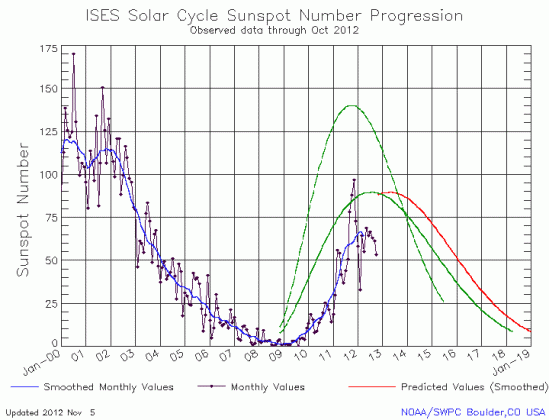The Sun takes a plunge
The latest monthly update the ongoing sunspot cycle of the Sun has been published today by NOAA. Once again, the trend suggests that the Sun’s ability to produce sunspots is fading, and fading fast.
I have posted this latest graph, covering the month of October, below the fold, with additional analysis.

In October the Sun’s production of sunspots dipped again, the fourth month in a row. The drop was steep, dropping the Sun’s activity to level below that of February 2011, when the ramp up to solar maximum was just beginning. In fact, the plunge in activity since late last year suggests that the Sun’s maximum might have already passed.
To give some perspective on these numbers, I have added to the graph, in green, the original predictions of the solar scientist community from April 2007. At that time the community was split, with half believing the next maximum would be one of the strongest on record and half believing it would be a weak maximum. As you can see, both were wrong, by significant numbers. In 2009 the scientists abandoned the strong prediction while simultaneously shifting the predicted moment of peak maximum for the weak prediction to early in 2013.
Based on the real numbers, even the weak prediction looks increasingly like it will be too strong a prediction.
We can see some interesting things by putting these predictions on the graph. For reasons no one can explain, the Sun’s peak activity so far happens to correspond with the strong prediction’s peak, even though the level of activity was far less. And if the decline of activity that we have been seeing for the past six months continues, the overall shape of the curve will resemble the original weak prediction, though much weaker by far.
Meanwhile, the solar scientists at the Marshall Space Flight Center have once again adjusted their prediction for the upcoming maximum, lowering their predicted peak sunspot number from 75 to 73. This is the second month in a row that they have lowered their prediction.
All in all, the Sun simply does not seem to be able to produce many sunspots this solar maximum. And the question still remains, will it be able to do it at all in the coming decades, once this solar maximum passes?
On Christmas Eve 1968 three Americans became the first humans to visit another world. What they did to celebrate was unexpected and profound, and will be remembered throughout all human history. Genesis: the Story of Apollo 8, Robert Zimmerman's classic history of humanity's first journey to another world, tells that story, and it is now available as both an ebook and an audiobook, both with a foreword by Valerie Anders and a new introduction by Robert Zimmerman.
The print edition can be purchased at Amazon or from any other book seller. If you want an autographed copy the price is $60 for the hardback and $45 for the paperback, plus $8 shipping for each. Go here for purchasing details. The ebook is available everywhere for $5.99 (before discount) at amazon, or direct from my ebook publisher, ebookit. If you buy it from ebookit you don't support the big tech companies and the author gets a bigger cut much sooner.
The audiobook is also available at all these vendors, and is also free with a 30-day trial membership to Audible.
"Not simply about one mission, [Genesis] is also the history of America's quest for the moon... Zimmerman has done a masterful job of tying disparate events together into a solid account of one of America's greatest human triumphs."--San Antonio Express-News


Now we’ll have the natural experiment to show just how much of the warming in the 20th century was due to the sun’s influence as opposed to CO2.
“Meanwhile, the solar scientists at the Marshall Space Flight Center have once again adjusted their prediction for the upcoming maximum, ”
Not much of a prediction if it changes every month. I understand why they are doing it but perhaps they should coin a new term that matches what they are doing.
I think the term you’re looking for is ‘guessing’.
It would be sensible to understand we are at the beginning of a good data cycle. We should definitely preserve the data in its raw form. Anyone wishing to jump off the CO2 bridge should remember the O2 part might come in handy for breathing and H2O. In any case we should realize we are in a pre-theory time frame. I like spitballing instead of guessing.
Mr. Zimmerman:
Thank you for following and showing this to be guesswork on the part of the scientific community. I for one, believe the Sun is the largest part of the climate equation, influencing global climate, as opposed to CO2. I recall Carl Sagan in his series Cosmos propounded both concerns of global cooling (in the 1970s) and global warming, in his 1990s postscript updates to Cosmos. Certainly, if Sagan was not certain, I doubt we have any more data today to be more certain of what the climate will be or what the Sun’s activity will be – which is illustrated by these sunspot charts.
Rene Borbon
Bothell, Washington
USA